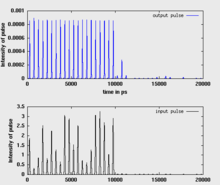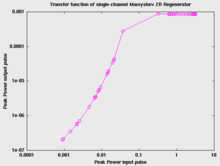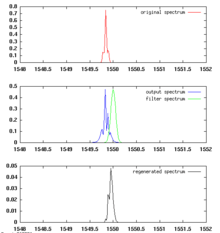Mamyshev 2R regenerator
The Mamyshev 2R regenerator is an all-optical regenerator used in optical communications. In 1998, Pavel V. Mamyshev of Bell Labs proposed and patented the use of the self-phase modulation (SPM) for single channel optical pulse reshaping and re-amplification.[1][2]
2R regenerator design
The schematic of the conventional Mamyshev regenerator is shown above. A High-Power Erbium doped fiber amplifier (HP-EDFA) boosts the incoming signal to the power (Pm) required for optimal peak power equalization of the ‘one’ symbols. This amplifier can be followed by an optical bandpass filter (not shown in the figure) in order to reject out of band amplified spontaneous emission.[3]
The self-phase modulation-induced spectral broadening is generated in a single-mode optical fiber with a length . The chromatic dispersion of this fiber is normal and its value is D. The nonlinear coefficient is , and the linear losses are . Several types of fibers have been successfully tested : non-zero dispersion-shifted fibers,[1] highly nonlinear silica fibers (HNLF), microstructured silica fibers,[4] chalcogenide fibers[5] or tellurite fibers.[6]
At the fiber output, an optical bandpass filter (OBPF) with a FWHM spectral width , (defined such that the pulse width at the output is the same as that at the input of the system), is spectrally offset by an amount with respect to the input signal carrier wavelength and is used to carve into the broadened spectrum - thereby acting as a pulse reshaper.

This is the unit configuration, which may be repeated for higher accuracy of the regeneration.
Note that it has been shown possible to advantageously replace the nonlinear fiber by a highly-nonlinear chalcogenide waveguide, therefore opening the way to all-integrated photonic chip regeneration.[7]
Principle of operation and design


The Mamyshev regenerator can handle return-to-zero signals with ultrahigh data bit rates. Indeed, thanks to the quasi-instantaneous response of the nonlinear Kerr effect, this regenerator does not suffer from the finite recover time of some saturable absorbers.
The interest of the Mamyshev regenerator lies in its ability to regenerate simultaneously the 'ones' and 'zeros' bit of information.
The key effect affecting the pulse evolution in the regenerator is the self-phase modulation that broadens the spectrum in proportion to the intensity of the initial optical pulse. Combined with an output frequency offset OBPF, this constitutes an efficient ultrafast thresholder. In more details, low intensity pulses or noise do not broaden significantly and fall outside of the off-centered BPF and hence the output for the noisy 0's in the data stream are reduced to the zero floor. On the contrary, for the 1's data pulses the intensity is sufficiently strong to broaden the spectra by SPM, and a significant portion of the spectrum falls into the OBPF passband, leading to a generation of the output 1's pulse.
For a careful design of the regenerator and an appropriate combination of filter parameter (spectral offset and bandwidth) / fiber parameter (length, dispersion and nonlinearity values),[8][9] a reduction of amplitude fluctuations can also be achieved, leading to power equalization of the pulse stream.
The modelling results for the 2R regenerator are shown with the article. In Figure 1, the upper panel shows regenerated pulse from the input (lower panel) for the Mamyshev 2R regenerator. Note how the noisy 1's pulses are boosted to same power levels in the output, while the 0's pulses are reduced to the noise floor.
An important property of a Mamyshev regenerator is its transfer function that links the output peak power to the input peak power. For an efficient operation and power equalization, this transfer function should exhibit a marked plateau at the 1's power level.[9] Example of a transfer function is provided Figure 2.
The spectral operations of broadening, filtering and regeneration about the central wavelength are shown in Figure 3.
Note also that in the design of this nonlinear regenerator, care should be given to avoid the consequences of deleterious Brillouin backscattering[10] as well as pulse to pulse interaction leading to patterning effects in the output sequence.[9][10]

Mamyshev regenerator - Variants
Due to the spectral filtering process, the regenerated pulse is intrinsically shifted from the original frequency. This can be beneficial if wavelength conversion is to be achieved simultaneously the regeneration and therefore channel switching can be considered.[11] However, if one wants to recover an output signal having the initial wavelength, an option of applying another regeneration with the BPF center frequency placed at the original channel center frequency allows to overcome this problem. Note that this can be done in a single fiber using a bidirectional propagation in the nonlinear fiber.[12]
Multichannel 2R Regeneration
The Mamyshev regenerator in its standard configuration is limited to single-wavelength operation in order to prevent from cross-phase modulation (XPM) effects from adjacent channels. Several schemes have been proposed to extend its region of operation to multichannel regime.
In their work on Four-wave mixing (FWM) compensation by using a HLNF and its XPM, Michael Vasilyev and co-workers have proposed,[13] and demonstrated up to 12-channel optical regeneration in 10Gbit/s systems.[14]
In other work, taking advantage of counter-propagating scheme, double wavelength regeneration has been demonstrated.[15] The number of channels that can be handled has been increased up to four thanks to polarization multiplexing.[16]
Efficient all-optical regeneration based on Mamyshev device has been demonstrated at various repetition rates : 10 Gbit/s, 40 Gbit/s and up to 160 Gbit/s.[11]
The Mamyshev regenerator may suffer from a poor yield : the spectral filtering of the expanded spectrum induces high intrisic energy loss. In order to compensate those losses, distributed Raman amplification can be involved[17] .
3R regeneration
The 2R regeneration can be combined with an additional stage of regeneration to provide 3R regeneration.[11][18]
Mamyshev technique has also been used for OCDMA transmission[19] and it has been proposed to use the Mamyshev setup in the framework of optical performance monitoring.[20] The reshaping features of the Mamyshev regenerator have also been combined with a polarization attraction process that enables to simultaneously regenerate thepolarization state and the intensity profile of degraded pulse streams.[21]
References
- 1 2 Mamyshev, P. V. (1998). "All-optical data regeneration based on self-phase modulation effect". 24th European Conference on Optical Communication. ECOC '98 (IEEE Cat. No.98TH8398). 1. pp. 475–476. doi:10.1109/ECOC.1998.732666. ISBN 84-89900-14-0.
- ↑ P.V. Mamyshev,"Method and apparatus for all-optical data regeneration", US Patent 6141129
- ↑ Nguyen, T.N.; Gay, M.; Bramerie, L.; Chartier, T.; Simon, J.C.; Joindot, Michel (2006). "Noise reduction in 2R-regeneration technique utilizing self-phase modulation and filtering". Otpics Express. 14 (6): 1737–1747. doi:10.1364/OE.14.001737.
- ↑ Petropoulos, P.; Monro, T.M.; Belardi, W.; Furusawa, F.; Lee, J.H.; Richardson, D.J. (2001). "2R-regenerative all-optical switch based on a highly nonlinear holey fiber". Optics Letters. 26 (16): 1233–1235. doi:10.1364/OL.26.001233. PMID 18049570.
- ↑ Fu, L.B.; Rochette, M.; Ta'eed, V. G.; Moss, D. J.; Eggleton, B.J. (2005). "Investigation of self-phase modulation based optical regeneration in single mode As2Se3 chalcogenide glass fiber". Optics Express. 13: 7639–7646. doi:10.1364/opex.13.007637.
- ↑ Parmigiani, F.; Asimakis, S.; Sugimoto, N.; Koizumi, F; Petropoulos, P.; Richardson, D. J. (2006). "2R regenerator based on a 2-m-long highly nonlinear bismuth oxide fiber". Optics Express. 14 (12): 5038–5044. doi:10.1364/OE.14.005038. PMID 19516664.
- ↑ Ta'eed, V.G.; Shokooh-Saremi, M.; Fu, L.; Moss, D. J.; Rochette, B.J.; Littler, I. C. M.; Eggleton, Benjamin J.; Ruan, Y.; Luther-Davies, B. (2005). "Integrated all-optical pulse regenerator in chalcogenide waveguides". Optics Letters. 30 (21): 2900–2902. doi:10.1364/OL.30.002900. PMID 16279463.
- ↑ Her, T.H; Raybon, G.; Headley, G. (2004). "Optimization of pulse regeneration at 40 Gb/s based on spectral filtering of self-phase modulation in fiber". IEEE Photon. Technol. Lett. 16: 200–202. doi:10.1109/LPT.2003.819367.
- 1 2 3 Provost, L.; Finot, C.; Mukasa, K.; Petropoulos, P.; Richardson, D. J. (2007). "Design scaling rules for 2R-Optical Self-Phase Modulation-based regenerators 2R regeneration". Optics Express. 15 (8): 5100–5113. doi:10.1364/OE.15.005100. PMID 19532760.
- 1 2 Nguyen, T. N.; Chartier, T.; Bramerie, L.; Gay, M.; Le, C.; Lobo, S.; Joindot, M.; Simon, J. C.; et al. (2009). "Self-phase-modulation-based 2R regenerator including pulse compression and offset filtering for 42.6 Gbit/s RZ-33% transmission systems". Optics Express. 17 (20): 17747–17757. doi:10.1364/OE.17.017747. PMID 19907561.
- 1 2 3 Murai, H.; Kanda, Y.; Kagawa, M.; Arahira, S. (2009). "Regenerative SPM-based wavelength conversion and field demonstration of 160-Gb/s all-optical 3R operation". J. Lightw. Technol. 28: 910–921. doi:10.1109/jlt.2009.2035061.
- ↑ Matsumoto, M. (2006). "Efficient all-optical 2R regeneration using self-phase modulation in bidirectional fiber configuration". Optics Express. 14 (23): 11018–11023. doi:10.1364/OE.14.011018. PMID 19529517.
- ↑ http://www.opticsinfobase.org/ol/abstract.cfm?id=84193
- ↑ http://ieeexplore.ieee.org/xpl/login.jsp?tp=&arnumber=4771754
- ↑ Provost, L.; Parmigiani, F.; Finot, C.; Mukasa, K; Petropoulos, P.; Richardson, D. J. (2008). "Analysis of a two-channel 2R all-optical regenerator based on a counter-propagating configuration". Optics Express. 16 (3): 2264–2275. doi:10.1364/OE.16.002264. PMID 18542306.
- ↑ Provost, L.; Parmigiani, F.; Petropoulos, P.; Richardson, D. J.; Mukasa, K.; Takahashi, H.; Hiroishi, J.; Takakuma, M. (2008). "Investigation of four-wavelength regenerator using polarization- and direction- multiplexing". IEEE Photon. Technol. Lett. 20 (20): 1676–1678. doi:10.1109/LPT.2008.2003389.
- ↑ Finot, C.; Fatome, J.; Pitois, S.; Millot, G.; Pincemin, E. (2011). "Active Mamyshev regenerator". Optical Review. 18 (3): 257–263. doi:10.1007/s10043-011-0052-9.
- ↑ Daikoku, M.; Yoshikane, N.; Otani, T.; Tanaka, H (2006). "Optical 40-Gb/s 3R Regenerator with a combination of the SPM and XAM effects for all-optical networks". J. Lightw. Technol. 24 (3): 1142–1148. doi:10.1109/JLT.2005.863330.
- ↑ Wang, X.; Hamanaka, T.; Wada, N.; Kitayama, K. (2005). "Dispersion-flattened-fiber baser optical thresholder for multiple-access-interference suppression in OCDMA system". Optics Express. 13 (14): 5499–5505. doi:10.1364/OPEX.13.005499. PMID 19498545.
- ↑ Westbrook, P. S.; Eggleton, B. J.; Hunsche, S.; Raybon, G.; Eggleton, B.J. (2002). "Measurement of pulse degradation using all-optical 2R regenerator". Electron. Lett. 38 (20): 1193–1194. doi:10.1049/el:20020837.
- ↑ Morin P., J. Fatome J., Finot C., Pitois S., Claveau R., and Millot, G. (2011). "All-optical nonlinear processing of both polarization state and intensity profile for 40 Gbit/s regeneration applications". Optics Express. 19 (18): 17158–17166. doi:10.1364/OE.19.017158. PMID 21935078.